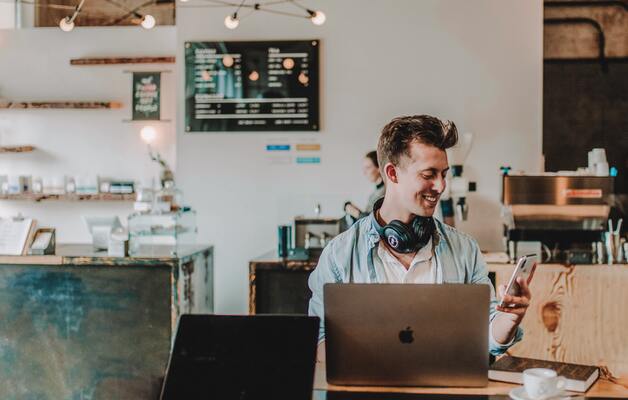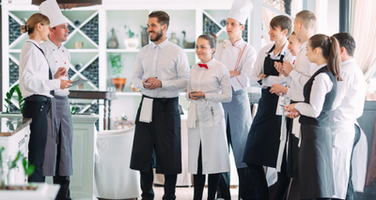
The past two years have undoubtedly been as transformative as they have been disruptive for the hospitality industry across the US and around the globe.
The mindset around technology in restaurants has changed dramatically - and permanently.
As an industry, hospitality has traditionally been slow to adapt to new technologies and adopt new ways of working but changes brought on by the global pandemic are here to stay.
Much like how eCommerce revolutionized retail after the financial crisis in 2007-8, the pandemic has forced hospitality to become “bricks and mobile”.
The hospitality industry has been undergoing fundamental changes over the past few years, but the pandemic highlighted and exacerbated structural faults, and this has accelerated the business need to adapt to a new environment.
Global labor shortages and increasing minimum wages are forcing restaurants and venues to adapt their service model. The pandemic and lockdowns across the world triggered the mass adoption of online ordering technology, heralding an industry-wide transformation in the way people pay for food and drinks.
One of the biggest innovations of the past few years has been the adoption of order-at-table technology across the broader hospitality industry, largely driven by the increased prevalence and consumer acceptance of QR codes.
According to the National Restaurant Association’s 2021 State of the Industry report, almost two-thirds of fine dining operators in the US and more than half of both family dining and casual dining operators say staffing levels are currently more than 20% below normal.
And the majority of operators across all restaurant segments say front-of-house has unfilled job openings.
Mobile ordering solves this problem and allows venues to trade even if experiencing a staff shortage, as the technology takes care of the rote, administrative tasks of service - taking orders, organizing payments - and helps staff to service more customers at the one time. Freeing staff from rote tasks also allows them to create more meaningful interactions with customers in a hospitality environment. This increases tips, average spend and helps drive repeat venue visitation.
According to the National Restaurant Association, lockdowns throughout 2020 caused more than 110,000 restaurants across the US to close either long-term or permanently. And across all hospitality segments (with the exception of QSR/quick service restaurants) about 9 in 10 operators reported lower profit margins compared with pre-Covid.
During 2021 and continuing into 2022, mobile ordering technology has helped the industry recover from the profound economic shock of the pandemic by increasing average customer spend and overall satisfaction. This change in consumer behavior, accelerated during the pandemic, has already become cemented and will continue to gain widespread traction and acceptance.
For instance, by offering suggested menu add ons and upsells, venues experience an increase in average order size of between 20-40%. In an industry with increasingly tight margins coupled with capacity restrictions - either through local regulation or staff shortages - this increase in customer spend-per-head is vital and enables venues to not only survive, but thrive.
The adoption of QR codes in hospitality’s service model has alerted the industry to the power and benefits of capturing their customer data to increase and differentiate their hospitality offering. Venues have the ability to deliver an enhanced experience thanks to greater personalization, taking the human element of hospitality and enhancing it by informing it with data - for example, knowing a customer’s favorite drink or dietary preferences.
The inclusion of technology in a hospitality environment has been increasingly embraced by consumers, with more than a third of all people (36%)1 now preferring to digitally order and pay for food and beverage.
Innovation in consumer choice is accelerating the transformation of payments within a hospitality environment, and according to the NRA more than 1 in 5 customers planning to dine in a restaurant say offering a contactless or mobile payment option would factor into their restaurant choice.
This is a global phenomenon.
In Los Angeles, almost 1 in 2 people2 say they would now be likely to choose a venue that offered a menu via scanning a QR code over a venue that only offered physical menus.
In the UK, 7 in 10 people are now likely to choose a pub that offers table service rather than ordering at a bar, and almost 70% are likely to choose a venue where they can order food and drink on their phone3.
In New Zealand, compared with prior to the pandemic, 61% of Kiwis are now likely to choose a venue where they can order on their phone4.
And in the past 12 months, 44% of Australians have used the Mr Yum ordering and payments platform when dining out.
In the US, diners across all age groups are increasingly tech-savvy when it comes to ordering via a smartphone, with more than 70 per cent having used a phone to order takeaway food5. Almost 6 in 10 people (58.6%) have used a smartphone to order food or drink in a venue, with more than 50% of those who have aged 35 years or older6.
One in three people never or rarely order a daily special recited by a server, but more than 4 in 5 will order a suggested side dish when ordering on a smartphone7, highlighting a key benefit implementing order-and-pay technology provides venue operators. Adopting this technology is good for staff, too. In New Zealand - which does not have a tipping culture - just 1 in 3 people say they usually leave a tip when visiting a hospitality venue, but when ordering food and drink on their phone, that surges to more than 1 in 2 people8.
In the UK, when ordering food and drink on their phone 86% of people will order a second drink, 7 in 10 people will leave a tip and more than 6 in 10 will order a premium brand of spirit for a mixed drink instead of the house brand9.
When visiting a hospitality venue, the top 3 biggest irritants cited by diners10 are: :
- Queuing for food or drinks
- Waiting for a server to take an order
- Not knowing what a dish looks like before ordering it
By implementing at table order-and-pay technology a venue creates operational efficiencies for staff while simultaneously offering a better customer experience - and happy customers are returning customers.
An increasingly exciting development in creating happy customers is using data-driven insights to shape the dining experience by remembering past orders and suggesting new experiences.
Mobile ordering platforms can help refine the customer experience by remembering preferences, and provide restaurants with customer data that, in turn, can be used for customized, sophisticated and keenly targeted marketing campaigns.
Menu browsing and order history can be used to offer specials and inducements to returning customers. A diner who regularly orders steak might be offered a glass of red wine on their next visit, someone who changed their order at the last minute might be offered a special deal on the dish they didn’t try, while those with dietary restrictions can be targeted with focused offers and communication - no “Sunday roast” emails sent to a vegan, for instance.
Technology will never take away the humanity of hospitality.
But it is creating the restaurant of the future and by embracing the powerful tools mobile ordering technology offers both customers and operators, venues have the best chance of not only surviving, but thriving.







